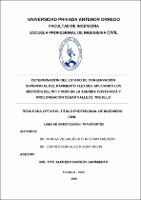Determinación del estado de conservación superficial del pavimento flexible aplicando los métodos del PCI y VIZIR en la avenida costa rica y prolongación César Vallejo, Trujillo

Ver/
Descargar
(application/pdf: 16.23Mb)
(application/pdf: 16.23Mb)
Fecha
2019Autor(es)
Murga Villanueva, Christian Fabrizio
Zerpa Rodríguez, Roger Kevin
Metadatos
Mostrar el registro completo del ítemResumen
El presente trabajo de investigación, tuvo como objetivo conseguir un indicador del estado de condición superficial del pavimento flexible, haciendo uso de los métodos PCI (Índice de Condición del Pavimento) basado en la Norma ASTM D6433-11 y VIZIR, (desarrollado por el Laboratorio Central de Puentes y Carreteras– Francia), donde se realizó un análisis y comparación de sus resultados teniendo en cuenta sus similitudes y diferencias que puedan presentar ambos métodos; basándose en el método del PCI, las muestras estuvieron conformadas por las divisiones de las vías en varios tramos de longitudes de 25.7 m cada uno, que nos dio un total de 28 tramos, 14 de ida y 14 de vuelta las cuales fueron evaluadas.
Por lo consiguiente se realizó la evaluación por el método VIZIR donde se tomaron muestras de 100 m dando un total de 48 muestras, 24 de ida y 24 de vuelta. Se recolectaron los datos de las fallas existentes en la vía, como su nivel de severidad y su extensión que estas presentaban según corresponda por cada método, con el apoyo fundamental de los catálogos de las fallas para pavimentos asfalticos de los distintos métodos y con apoyo de los instrumentos de medición, se realizó el procesamiento de datos se obtuvo que nuestro índice del estado de conservación de la vía Prolongación César Vallejo y Avenida Costa Rica, mediante el método PCI se obtuvo un 52.06 el cual representa una calificación regular y por el método VIZIR un 2.25 con una calificación de bueno. De lo cual concluimos que el método PCI es el que determina y clasifica con mayor criterio las fallas observadas. The objective of this research work was to obtain an indicator of the state of the flexible pavement condition, the use of the PCI (Pavement Condition Index) methods based on ASTM D6433-11 and VIZIR, (developed by the Laboratory Central Bridge and Roads - France), where an analysis and comparison of its results takes place taking into account their similarities and differences that can be presented by both methods; The PCI method, the samples were formed by the divisions of the tracks in several sections of lengths of 25.7 m each, which gave us a total of 28 sections, 14 outbound and 14 return, which are evaluated.
Therefore, the evaluation was carried out by the VIZIR method where samples of 100 m were taken in a total of 48 samples, 24 one-way and 24-round. Compilation of the data of the faults existing in the road, such as its level of severity and its extension that will be presented as appropriate for each method, with the fundamental support of the catalogs of the faults for asphalt pavements of the different methods and with the support of the measurement instruments, the data processing was developed, the maintenance status index of the César Vallejo Prolongation and Avenida Costa Rica was obtained, by means of the PCI method a score of 52.06 was obtained, which represents a regular score and by the method VIZIR a 2.25 with a good rating. According to what the PCI method is, the observed faults are determined and classified with greater criteria.
Palabras clave
Colecciones
- Ingeniería Civil [1260]

